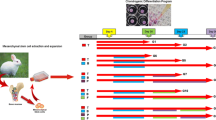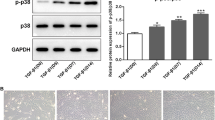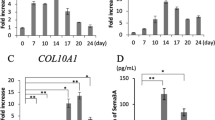Summary
This study examined the construction of eukaryotic expression plasmid of human transforming growth factor-β3 (hTGF-β3) and its inducing effect on the differentiation of precartilaginous stem cells (PSCs) into chondroblasts. hTGF-β3 gene was amplified by using polymerase chain reaction (PCR) and then inserted into the eukaryotic expression plasmid pcDNA3.1 to construct the eukaryotic expression plasmid pcDNA3.1(+)-hTGF-β3. Rat PSCs were isolated and purified by employing an immunomagnetic cell sorting system. pcDNA3.1(+)-hTGF-β3 was transfected into purified PSCs with the use of linear polyamines. The expression of TGF-β3 and cartilage-specific extracellular matrix (ECM) components was detected after transfection by real-time quantitative PCR, ELISA, immunochemistry and Western blotting, respectively. The results showed that the eukaryotic expression plasmid pcDNA3.1(+)-hTGF-β3 was successfully established as identified by enzyme digestion and DNA sequencing. Real-time quantitative PCR and ELISA revealed that hTGF-β3 was strongly expressed in pcDNA3.1(+)-hTGF-β3-transfected PSCs. Real-time quantitative PCR, immunochemistry and Western blotting showed that the cartilage-specific ECM markers, i.e., cartilage oligomeric matrix protein (COMP), Aggrecan, collagen type X and II were intensely expressed in the pcDNA3.1(+)-hTGF-β3-transfected cells. It was concluded that hTGF-β3 could be stably expressed in pcDNA3.1(+)-hTGF-β3-transfected PSCs and induce the differentiation of PSCs into chondroblasts.
Similar content being viewed by others
References
Thirion S, Berenbaum F. Culture and phenotyping of chondrocytes in primary culture. Methods Mol Med, 2004,100:1–14
Robinson D, Hasharoni A, Cohen N, et al. Fibroblast growth factor receptor-3 as a marker for precartilaginous stem cells. Clin Orthop, 1999,367 (Suppl):S163–S175
Massagué J, Hata A, Liu F. TGF-β signaling through the Smad pathway. Trends Cell Biol, 1997,7(5):187–192
Moses L, Serra R. Regulation of differentiation by TGF-β. Curr Opin Gen Dev, 1996,6(5):581–586
Hoodless A, Wrana L. Mechanism and function of signaling by the TGF-β superfamily. Curr Top Microbiol Immunol, 1998,228:235–272
You HB, Chen AM. Transfection of precartilaginous stem cells with enhanced green fluorescence protein gene and transforming growth factor β3 inducing chondrogenesis in precartilaginous stem cells. Chin J Pediatr Sur (Chinese), 2004,25(6):545–549
You HB, Chen AM, Cheng H. Immunomagnetic separation to isolate and purify precartilaginous stem cells from neonate rats. Chin J Trauma (Chinese), 2004,20(10):33–35
Livak KJ, Schmittgen TD. Analysis of relative gene expression data using real-time quantitative PCR and the 2(-Delta Delta C(T)) method. Methods, 2001,25(4):402–408
Chubinskaya S, Kuettner KE. Regulation of osteogenic proteins by chondrocytes. Int J Biochem Cell Biol, 2003,35(9):1323–1340
van den Berg WB, van der Kraan PM, Scharstuhl A, et al. Growth factors and cartilage repair. Clin Orthop, 2001,391(Suppl):S244–S250
Grimaud E, Heymann D, Redini F. Recent advances in TGF-beta effects on chondrocyte metabolism. Potential therapeutic roles of TGF-beta in cartilage disorders. Cytokine Growth Factor Rev, 2002,13(3):241–257
Miyazono K. TGF-beta signaling by Smad proteins. Cytokine Growth Factor Rev, 2000,11(1–2):15–22
Cox DA. Transforming growth factor-beta 3. Cell Biol Int, 1995,19(5):357–371
Roberts AB, Kondaiah P, Rosa F, et al. Mesoderm induction in Xenopus laevis distinguishes between the various TGF-beta isoforms. Growth Factors, 1990,3(4):277–286
Bostrom MP, Asnis P. Transforming growth factor beta in fracture repair. Clin Orthop, 1998,355(Suppl):S124–S131
Hosokawa R, Nonaka K, Morifuji M, et al. TGF-beta 3 decreases type I collagen and scarring after labioplasty. J Dent Res, 2003,82(7):558–564
Na K, Kim S, Woo DG, et al. Synergistic effect of TGFbeta-3 on chondrogenic differentiation of rabbit chondrocytes in thermo-reversible hydrogel constructs blended with hyaluronic acid by in vivo test. J Biotechnol, 2007,128(2):412–422
O’Kane S, Ferguson MW. Transforming growth factor betas and wound healing. Int J Biochem Cell Biol, 1997,29(1):63–78
Flanders KC, Burmester JK. Medical applications of transforming growth factor-beta. Clin Med Res, 2003,1(1):13–20
Zhang AG, Dong QR. Research advances in gene-enhanced cartilage tissue-engineering. Chin J Orthop Trauma (Chinese), 2005,7(5):476–479
Gebhart CL, Kabanov AV. Evaluation of polyplexes as gene transfer agents. J Control Release, 2001,73(2–3): 401–416
Lungwitz U, Breunig M, Blunk T, et al. Polyethyleni mine-based non-viral gene delivery systems. Eur J Pharm Biopharm, 2005,60(2):247–266
David A. Transforming growth factor-beta3. Cell Biol Int, 1995,19(5):357–371
Zaucke F, Dinser R, Maurer P, et al. Cartilage oligomeric matrix protein (COMP) and collagen IX are sensitive markers for the differentiation state of articular primary chondrocytes. Biochem J, 2001,358(1):17–24
Author information
Authors and Affiliations
Corresponding author
Additional information
This project was supported by a grant from the National Natural Sciences Foundation of China (No. 30571873).
Rights and permissions
About this article
Cite this article
You, H., Chen, A., Liu, T. et al. Construction of eukaryotic expression plasmid of hTGF-β3 and its inducing effect on differentiation of precartilaginous stem cells into chondroblasts. J. Huazhong Univ. Sci. Technol. [Med. Sci.] 31, 524–529 (2011). https://doi.org/10.1007/s11596-011-0484-2
Received:
Published:
Issue Date:
DOI: https://doi.org/10.1007/s11596-011-0484-2




